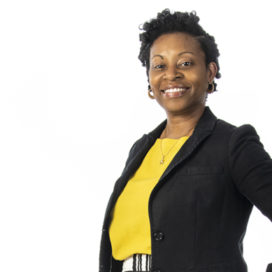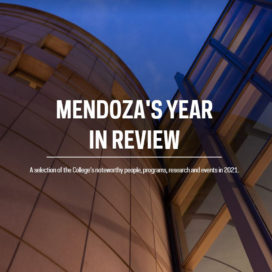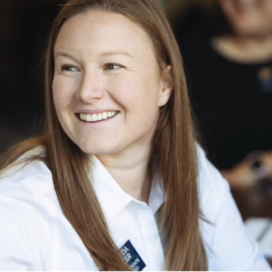Seven glimpses of tomorrow
Published: December 10, 2010 / Author: Ed Cohen
Notre Dame’s Mendoza College of Business is the first university to require business majors to take a course in foresight.
Foresight in Business and Society, taken junior year, begins with an exploration of major emerging challenges – including sustainability, population growth, climate change, and issues caused by changing demographics. Working in teams, students then conduct an in-depth analysis of an issue and prepare a research report and poster to be presented at the end of the semester.
Here are some highlights from posters presented at the end of the fall 2010 semester.
- Future of Wind-Turbine Manufacturing
With wind turbines sprouting on what seems like every wind-swept plain and hill, it’s clear what a growth industry the manufacture of wind turbines will be.
But the bigger opportunity will be in servicing the energy-producing devices, this team concluded.
Team members talked with officials at General Electric, one of the producers of wind turbines, and found that the there will be a huge market opportunity for companies able to service and maintain domestic wind-turbine sites because the devices have a 20-year lifespan. And, unlike significant portions of the manufacturing process, this work cannot be outsourced.
“We came in with the wrong perspective,” said team member Moises Torres. “We thought it was all going to be in manufacturing. Manufacturing is important, but service is where most of the jobs are going to be created.”
- Meet the Meat
In Brazil, as in some other developing countries, the disparity between rich and poor is shrinking as a significant middle class begins to emerge. Historically, added affluence had led to increased consumption of a more-expensive food source, meat.
“When we looked at population and affluence levels in Brazil we found that they are very similar to where the United States was in 1960,” said team member Noelle Fosko.
The students in this team found that Brazilians are now consuming 90 kilograms of meat per person per year. That comes with 89.2 kg in the United States in 1960. If this trend continues, the figure would be 124 kg per person in Brazil by 2060, they said.
“We said we that would prefer that they eat less meat because too much meat is unhealthy and, also, it’s going to be a strain on resources,” said team member Brandy Cerne.
If Brazilians are going to eat meat, the team says, they’d be better off with foul. It takes 30% less water and half the amount of grain to produce a pound of chicken versus beef, they said.
- The Bangladeshi Water Crisis
In the 1970s the government of Bangladesh, the small impoverished country adjacent to India, installed thousands of tube wells in an effort to provide pathogen-free water. For the next two decades the wells seemed to work.
Then, in 1993, symptoms of previously unseen health conditions began to crop up. Researchers found that the wells contained poisonous levels of arsenic. The government can’t simply fill in the wells because for many people the well are their only source of water.
The solution, according to this team, is two-fold: one technological, the other educational.
Donor organizations are already supplying the country with chemical packets that remove the arsenic.
“[But] about 70% of citizens there say they would not be willing to pay for clean water,” said team member George Cardon.
He said Bangladeshis need to understand the value of water sanitation.
- Outsourcing of Manufacturing: What does the future hold?
Recent decades have seen countless U.S. manufacturing jobs move overseas to countries with cheaper labor. But that trend may be about to change.
“There is still otuscoursing happening…but now what you’re seeing is more in-sourcing, jobs coming back to the United States,” said team member Felix J. Zaczek V.
The reasons, they say, are the increasing cost of the “logistics” of foreign production along with the rising cost of labor in economically expanding countries like China.
Zaczek said the Chinese economy is beginning to resemble that of the United States before outsourcing. His team predicts that China will look to outsource some of its own manufacturing to cheaper-labor locations in Africa and Indonesia.
At the same time, he says, look for U.S. manufacturers to reexamine their practices.
“Back in the ’50s and ’60s, when we saw the first trickles of outsourcing, companies did it because of cost. They said, ‘We can get cheap labor, let’s just send it over there.’ Starting in late ’90s, with logistics starting to get more expensive, they just did it out of reflex – ‘OK, we’re going to outsource, it’s cheaper.’
“Now they’re doing more detailed cost analyses and they’re finding, ‘Wait a second, keeping more manufacturing processes in the United States may be more cost effective.”
- Solar Energy: The Future?
At present rates of consumption and with present technology, enough coal exists to coal power the world for 60 years.
With solar energy, the figure is more like 2,700 years.
“It’s not a matter of if we’re going to run out of these fossil fuels, it’s a matter of when,” said team member Ryan Coughlin. “It’s important that we get on board quickly and move toward renewable sources of energy so we’re not left in a hole 40, 50 years from now.”
This team recommends that the U.S. government: continue to offer tax breaks for purchase of solar equipment; require businesses to use a certain percentage of power made from renewable technologies like solar; fund both construction of solar power facilities and research into advancing the efficiency of the technology; and create a competitive market for solar technologies, similar to that which exists for military contracts, to drive future innovation and development.
- Corporate Philanthropy: Do corporations really care, and are they putting their resources where their pocketbooks are in the face of economic crisis?
This team’s answers is, it’s unclear.
Maria Kim says no standards exist for reporting philanthropic and community-service endeavors by corporations. Some companies appear to include among their own donations those made by their employees. The same goes for volunteer work carried out on company time versus personal time.
In other cases, she says, it’s unclear whether corporate outreach efforts are selfless or self-serving. For example, tobacco companies have launched campaigns to discourage youth smoking. But the companies always include their name in the messages, so is this philanthropy or marketing?
For these reasons, she says, it’s unclear how much benefit communities can expect from corporate philanthropy in the future.
- Universal Primary Education: An Attainable Goal in Sub-Saharan Africa?
The United Nations set a goal of universal primary education worldwide by 2015.
Countries in sub-Saharan Africa are not going to make that deadline. But they can get everything in place relatively quickly to make a run at it, says this team.
The prerequisites: government funding – for textbooks and other classroom materials, including laptop computers – and a change in attitude on the part of African parents.
Right now, the student say, demand for primary education is low in many African families because children are expected to work to help support the family.
“[Education is] more of a long-term benefit,” said team member Richard Ryan. “[Having the children] working is a short-term benefit for a family, the income. They need to sacrifice that income so they can reap the long-term rewards.”
Instead of 2015, a more realistic goal for universal primary education in sub-Saharan African would be around 2035, this team says.
/news_and_events/news_articles/article/8091/seven-glimpses-of-tomorrow




